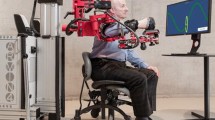Abstract
Robotic guidance is an engineered form of haptic-guidance training and intended to enhance motor learning in rehabilitation, surgery, and sports. However, its benefits (and pitfalls) are still debated. Here, we investigate the effects of different presentation modes on the reproduction of a spatiotemporal movement pattern. In three different groups of participants, the movement was demonstrated in three different modalities, namely visual, haptic, and visuo-haptic. After demonstration, participants had to reproduce the movement in two alternating recall conditions: haptic and visuo-haptic. Performance of the three groups during recall was compared with regard to spatial and dynamic movement characteristics. After haptic presentation, participants showed superior dynamic accuracy, whereas after visual presentation, participants performed better with regard to spatial accuracy. Added visual feedback during recall always led to enhanced performance, independent of the movement characteristic and the presentation modality. These findings substantiate the different benefits of different presentation modes for different movement characteristics. In particular, robotic guidance is beneficial for the learning of dynamic, but not of spatial movement characteristics.





Similar content being viewed by others
References
Armstrong TR (1970) Feedback and perceptual-motor skill learning: a review of information feedback and manual guidance training techniques. Tech Rep No. 25, Ann Arbor, University of Michigan, Department of Psychology
Bluteau J, Coquillart S, Payan Y, Gentaz E (2008) Haptic guidance improves the visuo-manual tracking of trajectories. PLoS One 3:e1775
Feygin D, Keehner M, Tendick F (2002) Haptic guidance: experimental evaluation of haptic training method for a perceptual motor skill. In: Proceedings of the 10th international symposium haptic interfaces environment and teleoperator systems (haptics 2002), pp 40–47
Georgopoulos AP (2002) Cognitive motor control: spatial and temporal aspects. Curr Opin Neurobiol 12:678–683
Gillespie RB, O’Modhrain MS, Zaretzky D, Pham C (1998) The virtual teacher. ASME Int Mech Eng Conf Expo
Grindlay G (2008) Haptic guidance benefits musical motor learning. In: Proceedings of the symposium haptic interfaces virtual environ and teleoperator systems, pp 397–404
Henmi K, Yoshikawa T (1998) Virtual lesson and its application to virtual calligraphy system. IEEE Int Conf Robotics Autom 2:1275–1280
Heuer H (1984) On re-scalability of force and time in aiming movements. Psychol Res 46:73–86
Holding DH (1970) Learning without errors. In: Smith LE (ed) Psychology of motor learning. Athletic Institute, Chicago, pp 59–74
Holding DH, Macrae AW (1964) Guidance, restriction and knowledge of results. Ergonomics 7:289–295
Krauth J (1995) Testkonstruktion und Testtheorie. Psychologie Verlags Union, Weinheim
Liu J, Cramer SC, Reinkensmeyer DJ (2006) Learning to perform a new movement with robotic assistance: comparison of haptic guidance and visual demonstration. J NeuroEng Rehabil 3:20
Lüttgen J, Heuer H (in press) The influence of haptic guidance on the production of spatio-temporal patterns. Hum Movement Sci. doi:10.1016/j.humov.2011.07.002
Mahar D, MacKenzie B, McNicol D (1994) Modality-specific differences in the processing of spatially, temporally, and spatiotemporally distributed information. Percept 23:1369–1386
Marchal-Crespo L, Reinkensmeyer DJ (2008a) Haptic guidance can improve motor learning of a steering task. J Motor Behav 40:545–556
Marchal-Crespo L, Reinkensmeyer DJ (2008b) Effect of robotic guidance on motor learning of a timing task. In: Proceedings of the 2nd biennial IEEE/RAS-EMBS international conference on biomedical robotics and biomechatronics, pp 199–204
Marchal-Crespo L, Reinkensmeyer DJ (2009) Review of control strategies for robotic movement training after neurologic injury. J NeuroEng Rehabil 6:20
Marchal-Crespo L, Furumasu J, Reinkensmeyer DJ (2010) A robotic wheelchair trainer: design overview and a feasibility study. J NeuroEng Rehabil 7:40
Milot M-H, Marchal-Crespo L, Green CS, Cramer SC, Reinkensmeyer DJ (2010) Comparison of error-amplification and haptic guidance training techniques for learning of a timing-based motor task by healthy individuals. Exp Brain Res 201:119–131
Palluel-Germain R, Bara F, Hillairet de Boisferon A, Hennion B, Gouagout P, Gentaz E (2006) Early handwriting acquisition: evaluation of telemaque, a new visuo-haptic interface. In: Proceedings of the euroHaptics, pp 551–554
Palluel-Germain R, Bara F, Hillairet de Boisferon A, Hennion B, Gouagout P, Gentaz E (2007) A visuo-haptic device – Telemaque – increases kindergarten children’s handwriting acquisition. In: Proceedings of the IEEE world haptics 2007, pp 72–77
Poulton EC, Freeman PR (1966) Unwanted asymmetrical transfer effects with balanced experimental designs. Psychol Bull 66:1–8
Reinkensmeyer DJ, Patton JL (2009) Can robots help the learning of skilled actions? Exercise Sport Sci R 37:43–51
Reinkensmeyer DJ, Emken JK, Cramer SC (2004) Robotics, motor learning, and neurological recovery. Annu Rev Biomed Eng 6:497–525
Reinkensmeyer DJ, Galvez JA, Marchal-Crespo L, Wolbrecht ET, Bobrow JE. (2007) Some key problems for robot-assisted movement therapy research: a perspective from the University of California at Irvine. In: Proceedings of the 2007 IEEE international conference on rehabilitation robotics, pp 1009–1025
Schmidt RA, Lee TD (1999) Motor control and learning-a behavioral emphasis, 3rd edn. Human Kinetics, Champaign, pp 316–317
Shea CH, Wulf G, Park J-H, Gaunt B (2001) Effects of an auditory model on the learning of relative and absolute timing. J Motor Behav 33:127–138
Solis J, Avizzano CA, Bergamasco M (2002) Teaching to write Japanese characters using a haptic interface. In: Proceedings of the 10th international symposium haptic interfaces virtual environment teleoperator systems (haptics 2002), pp 255–262
Teo C, Burdet E, Lim H (2002) A robotic teacher of Chinese handwriting. In: Proceedings of the 10th international symposium haptic interfaces virtual environment teleoperator systems, pp 335–341
Acknowledgments
The research reported in this paper was supported by the European Community’s Seventh Framework Programme, Grant Agreement Number 231724 (HUMOUR). We thank Andreas Volgmann for software support and Sarah Jacobs for support in running the experiment.
Author information
Authors and Affiliations
Corresponding author
Rights and permissions
About this article
Cite this article
Lüttgen, J., Heuer, H. Robotic guidance benefits the learning of dynamic, but not of spatial movement characteristics. Exp Brain Res 222, 1–9 (2012). https://doi.org/10.1007/s00221-012-3190-9
Received:
Accepted:
Published:
Issue Date:
DOI: https://doi.org/10.1007/s00221-012-3190-9




